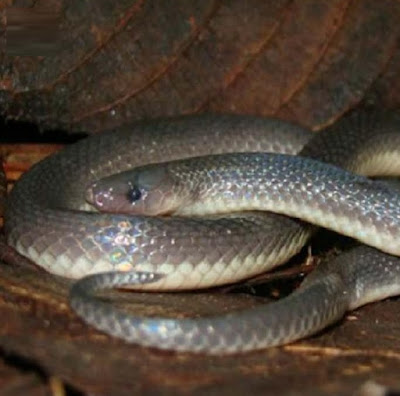 |
| Geophis berillus Barragán-Reséndiz, Pavón-Vázquez, Cervantes-Burgos, Trujano-Ortega, Canseco-Márquez & García-Vázquez, 2022 |
Abstract
We describe Geophis berillus sp. nov., a new species of the Geophis sieboldi group based on three specimens from the Valle de Bravo region in the Trans-Mexican Volcanic Belt, Estado de México, Mexico. The new species differs from all other members of this group by having 17 dorsal scale rows without apical pits, 149 and 151–152 ventrals (in males and females, respectively), and the lower portion of each scale in the first dorsal scale row pale. The new species is allopatric respective to other Geophis species. A phylogenetic analysis based on mitochondrial DNA (cyt-b) supports the inclusion of G. berillus sp. nov. in the G. sieboldi group and a sister relationship with G. sieboldi, a finding corroborated by morphological evidence.
KEYWORDS: Description, endemic, pine forest, semifossorial, taxonomy, Trans-Mexican Volcanic Belt
Geophis berillus sp. nov.
Etymology.— The specific name is treated as a noun inapposition and comes from the Latin ‘‘berillus,’’ meaning beryl. This mineral is colorless in its pure form but can attaina wide variety of colors in the presence of impurities. The name references the iridescent shine that is present throughout the otherwise dark body of all known specimensof the new species.
 |
| Habitat of Geophis berillus sp. nov. at the type locality. |
Lesly Montserrat Barragán-Reséndiz, Carlos J. Pavón-Vázquez, Romina Itzel Cervantes-Burgos, Marysol Trujano-Ortega, Luis Canseco-Márquez and Uri Omar García-Vázquez. 2022. A New Species of Snake of the Geophis sieboldi Group (Squamata: Dipsadidae) from Estado de México, Mexico. Herpetologica. 78(4); 268-276. DOI: 10.1655/Herpetologica-D-22-00011
Describimos a Geophis berillus sp. nov. una nueva especie del grupo Geophis sieboldi con base en tres especímenes de la región de Valle de Bravo en la Faja Volcánica Transmexicana. La nueva especie se diferencia de otros miembros del grupo por poseer 17 hileras de escamas dorsales sin fosas apicales, 149 y 152–153 ventrales (en machos y hembras, respectivamente) y la porción inferior de cada escama en la primera hilera de escamas dorsales clara. La nueva especie es alopátrica con respecto a otras especies de Geophis. Un análisis filogenético basado en DNA mitocondrial (cyt-b) respalda la inclusión de Geophis berillus sp. nov en el grupo G. sieboldi y su relación como grupo hermano de G. sieboldi, lo cual se corrobora con la evidencia morfológica.


